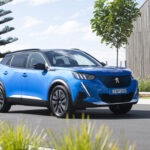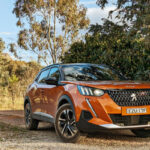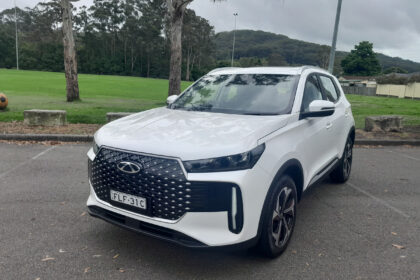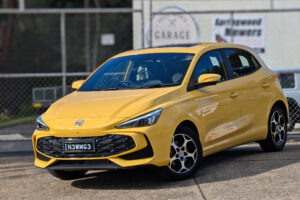
Peugeot Partner is the smallest of the French carmaker’s commercial van range,
sitting behind the mid-sized Expert and large Boxer.
There are three grades – City, Pro and Premium – with the choice of short and long
wheelbases in Pro and Premium.
The range also includes the e-Partner, the first fully-electric Peugeot to come here and our test vehicle. The e-Partner Pro LWB is priced at $59,990 plus on-
road costs.
Petrol versions range of the Partner range from $32,990 for the SWB City to $43,490 for the LWB
Premium.
STYLING
Partner is a neat and attractive vehicle with a relatively small grille above a black-
checkered fill.
The side features scalloped inserts above both wheel arches and parallel cladding at
the bottom of the doors.
Although the two Premium variants come with 16-inch alloy wheels, the e-Partner
Pro gets 16-inch steel.
LWB Premium and e-Partner are 4.75 metres long, just over 2.10 metres wide with
mirrors open and stand just under 1.90 metres high.
Turning circle is 11.4 metres.
With the batteries in e-Partner located under the floor load volume is 3.9 cubic
metres and it can carry a 735 kg of payload.
INTERIOR
Partner City and e-Partner come with two bucket seats but with no centre console or
storage space between them.
There are cup holders at the top of the dashboard for both driver and passenger.
Pro and Premium petrol variants get three bucket seats. While the centre seat is too
small for travelling any distance it can be fold back and lock in at 90-degrees to
provide the sort of storage that you’d normally get in a centre console.
Alternatively, with the base in place, the backrest can fold forward to reveal a flat
desktop which can slide forward to open up a small space for pens, notepads and
the like. It can even swivel sideways.
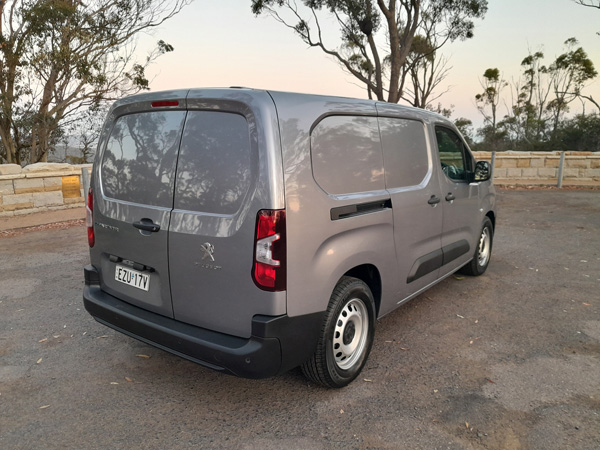
All models get the Peugeot i-Cockpit dashboard design which has been
progressively added to the company’s passenger vehicles with each upgrade.
The small, chunky steering wheel might look a bit out of place in a commercial
vehicle but it feels nice and, importantly, sits below the level of the instrument
cluster, avoiding the need to look through it at the dials.
Access to the storage area is through sliding doors on both sides or rear barn doors
which can be locked in at 90-degrees or opened to a full 180-degrees.
The interior can cater for a 1.2-metre square pallet.
Maximum payload in the short wheelbase model is 898kg and 1000kg in the LWB.
ENGINES/TRANMISSIONS
The petrol Partner models have a 1.2-litre Euro-6 compliant three-cylinder PureTech
turbo-petrol engine.
It generates 81kW in the Partner City and 96kW in the other variants, with 230Nm of
torque in both tunes.
Power is transmitted to the front wheels through an eight-speed automatic
transmission with a six-speed manual for City.
e-Partner is powered by a single electric motor linked to a 50kWh lithium-ion battery
that produces 100kW of power and 260Nm of torque and delivers a WLTP range of
258km.
While that range is relatively low when compared with passenger EVs, e-Partner is
unlikely to spend much time outside of urban areas and so will never be far away
from charging infrastructure.
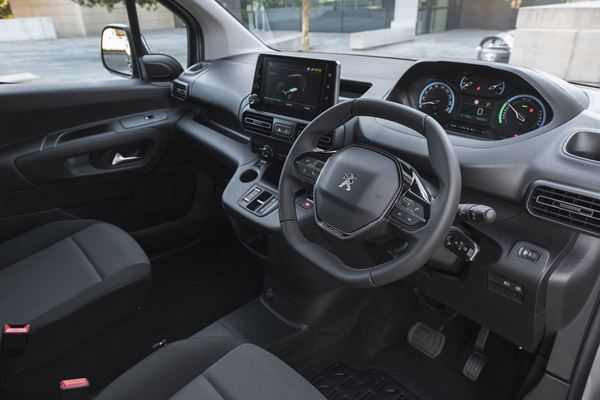
SAFETY
Standard safety features across the entire Partner range include six airbags,
electronic stability control, ABS brakes with electronic brakeforce distribution with
brake assist, hill start assist, programmable cruise control, speed limiter, rear parking
sensors and 180-degree reversing camera.
Variants above the entry-level City add automatic emergency braking, forward
collision warning, lane departure warning, lane keep assist, speed sign recognition,
tyre pressure warning and a high level third brake light at the top of the rear door.
Partner Premium and e-Partner add advanced driver attention alert and speed limit
recommendation.
e-Partner also gets an Acoustic Vehicle Alert System that generates an artificial
sound when travelling at low speed to alert pedestrians.
INFOTAINMENT
Display is through an 8.0-inch colour touchscreen (5.0-inch in City) mounted at the
centre top of the dashboard.
It’s easy to reach and intuitive to use with most features located there.
The picture is sharp and clear, especially important for the reversing camera which
plays such an important role in any van without side or rear windows.
The audio and air conditioning controls are circular knobs, also within easy reach.
All models above City get built-in satellite navigation, Apple CarPlay and Android
Auto connectivity, DAB digital radio and voice recognition.
The screen in the e-Partner also displays an ‘electric’ menu where you can view live
energy flows, consumption statistics and the ability to schedule a delayed charge.
DRIVING
Access into the Partner for people of average height is easy without little bending or
climbing required. The seats are well-shaped and comfortable.
The e-Partner is a surprisingly enjoyable vehicle to drive, more like an SUV than a
van and with the normal EV benefits of sharp acceleration and smooth, silent
running.
Visibility to the front 180-degrees is excellent with large windscreen, side windows
and mirrors.
To rear it’s a different story, with no windows either on the side or rear of the vehicle.
The rear vision camera does have a wide span but caution is needed when
reversing.
There are three driving modes in e-Partner: Eco providing 60kW and 190Nm, Normal
(80kW/210Nm) and Power (100kW/260Nm) with that last mode ideal for transporting
heavy loads.
e-Partner comes a Mode 3 public station charging cable but, oddly, not the usual
domestic cable which needs to be purchased separately.
Indicative charging times are about 7.5 hours from 0-100-percent via a 7.4kW
Wallbox, or around 30 minutes with a rapid charge from 0-80-percent capacity via a
100kW DC charger.
The charging point is located at the left-side rear.
With the battery fully charged the range showed at 282km, quite a bit above the
WLTP range of 258 km.
At motorway speed it dropped quite dramatically, however, 4km for each kilometre
travelled – but then levelled out when we hit the suburbs.
SUMMING UP
Load-carrying is obviously the e-Partner’s number-one priority, but it offers comfort
and refinement. That’s partly because it’s sold in some markets as a small people
mover.
It’s neat, functional and easy to drive with good cabin and load space.
Above the entry-level City variant there’s a good level of safety equipment.
RATINGS
Looks: 8/10
Performance: 8/10
Safety: 7/10
Thirst : 7/10
Practicality: 8/10
Comfort: 8/10
Tech: 8/10
Value: 7/10
AT A GLANCE
MODEL RANGE
Partner City SWB: $32,990 (manual)
Partner Pro SWB: $37,990 (automatic)
Partner Pro LWB: $40,990 (automatic)
Partner Premium SWB: $40,490 (automatic)
Partner Premium LWB: $43,490 (automatic)
Peugeot e-Partner LWB: $59,990 (EV)
Note: These prices do not include government or dealer delivery charges. Contact
your local Peugeot dealer for drive-away prices.
SPECIFICATIONS (Peugeot e-Partner Pro LWB electric vehicle)
POWERTRAIN
Battery Type: Lithium-ion
Battery Capacity: 50 kWh
On Board Charger: 74. kW
Maximum Power: 100 kW
Maximum Torque: 260 Nm
WLTP EV Range: 258 km
DIMENSIONS, WEIGHT AND CAPACITIES:
Length: 4753 mm
Wheelbase: 2975 mm
Width: 1921 mm
Height: 1880 mm
Turning Circle: 11.4 metres
Kerb Mass: 1632 kg
BRAKES:
Front: Ventilated disc
Rear: Solid disc
STANDARD WARRANTY:
Five years / 200,000 kilometres
Eight years / 160,000 km (battery)




